Consider this list, what do you see?
Eamon Coughlan ran the mile in 3:58:15 at 41 years
Dara Torres won three Silver medals at Olympics at the age of 41
Yekaterina Podkopayeva won the olympic 1500m final at 42 years
Sean Yates won the national 50-mile time-trial title at the age of 45 years
Nick Craig won veterans and National British mountain bike series titles aged 47 years
Ed Whitlock ran under 3hr for the marathon aged 73 years
Sister Madonna Buder completed 45 Ironman events aged 84 years
Hiroo Tanaka, from Japan, ran the 100 metres in 15.19 seconds aged 85 years.
Tom Moore, army veteran walked 100 lengths of his garden aged 99
Robert Marchand celebrated his 103rd birthday by climbing the Col Robert Marchand
What I see is that although performance declines with age, age itself is no barrier to success. You can probably be nationally competitive at 50 years….provided you don’t begin training at 45 years! What I am trying to say, is that in my opinion training and historical habits and current daily habits count more than simple age. Age is a number. You can almost ignore it. Now, can I prove it? First, let’s start with the bad news….what declines are typical with aging?
Headline Physical Changes
Here are key physiological changes limiting performance with age (somewhat simplified and assuming training is static!):
- Height tends to decrease by about 1cm per decade after age 40
- Weight and body fat increases by about 2.5% per decade
- Melanocytes, the skin cells producing melanin, diminish at a rate of some 2% annually in the 40s,
- blood oxygen-carrying capacity declines about 2% per decade
- VO2max decreases about 10% per decade (5ml/kg/min) per decade in untrained. About half of the VO2max decline is due to reduced oxygen extraction by muscles (A-V O2) and this is due to reduced mitochondrial number and lower quality capillaries which become less dense
- Half of VO2max decline is due to reduction is cardiac output (and this is mostly due to reduced HR), but also 15% decline in ejection fraction
- HRMax declines by about 1 beats per minute per year
- Lung forced vital capacity decreases by about 250ml per decade.
- Maximal voluntary ventilation decreases about 6% per decade, and the diffusion capacity of the lung by about 5% per decade
- Muscle strength and power is lost roughly 2- 3.5% per year
Now let’s look at aerobic (cycling/running) and anaerobic (lifting/strength) changes with age. If we look in more detail, the story is not that simple. It is not a straight line.
Aerobic Fitness vs Age
If we track performance by age closely in the lab or in field we see this:
VO2max vs age
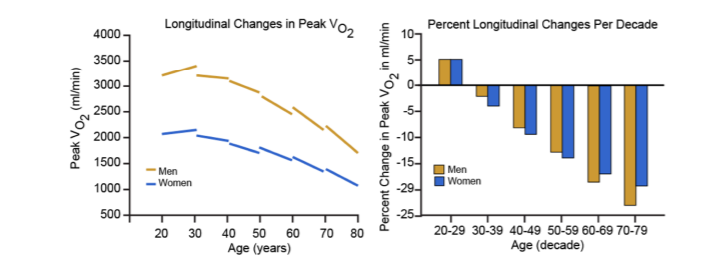
100m vs age
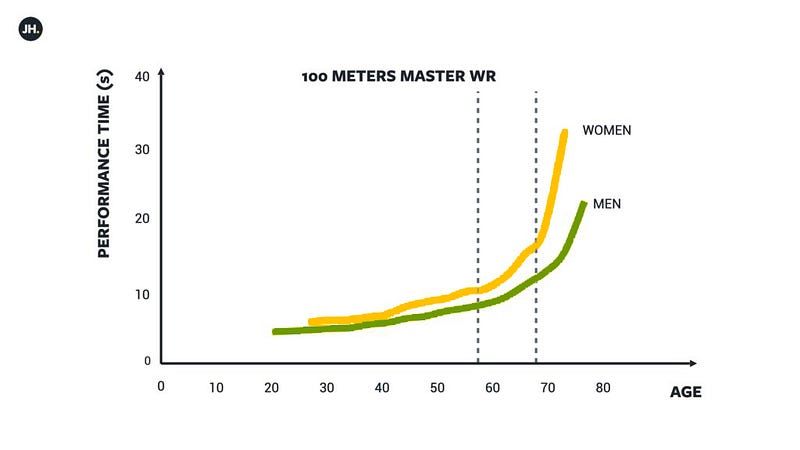
Marathon vs Age

Strength vs Age
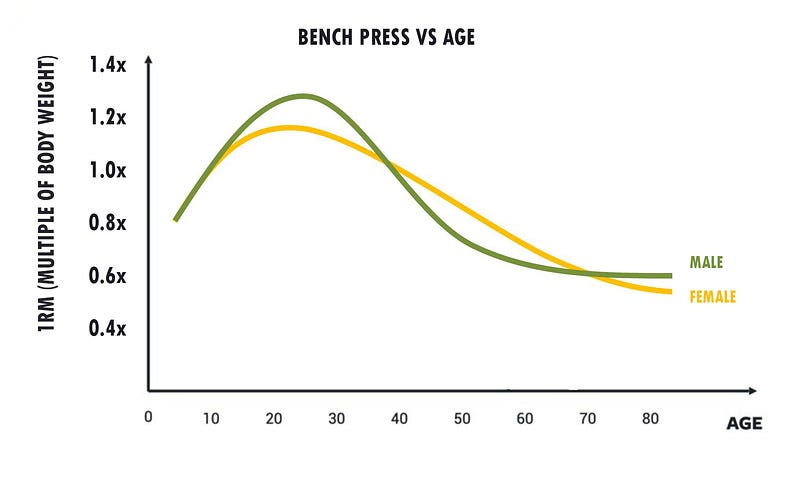 Big Data
Big Data

The last figure is interesting because it comprises all the primary data from 1500 individuals. With this it is possible to look at the contribution of age to curve fit which is roughly the same as asking
what % of the variation is strength is due to aging itself?
The answer is it depends on how much is due to other factors such as genetics, training history etc, but in beginners the effect of age is only 2–5% and in elites it might be 40% (and in the middle maybe around 10–20%). If you write them down all contributory factors, then it looks something like this (for those starting out):
What determines variations in strength or endurance?

Genetics seems to be the largest effect (citation). Now, we should examine these training effects in more detail, what we want to know if whether training is more effective at a younger or older age?
Training Effect with Age
Given that genetics, age and gender are fixed variables, and discounting the historical effect of what you did in the past (training years), then current training/coaching/events might contribute 65% of the variance in performance!
When you train, no doubt you get a big effect, provided you don’t give up of course. The effect is usually much larger than the effect of age alone. We can show this with real data. Here is the effect of training (elite vs just started within 6 months) on strength index of real athletes:

Training dominates the relatively modest effect of age, at least outside of age extremes. And now let’s look at the same factor (influence of age & training) on endurance (using the proxy of VO2max).
Actually, we used to think it looked like a straight line, like this, but this isn’t quite correct:
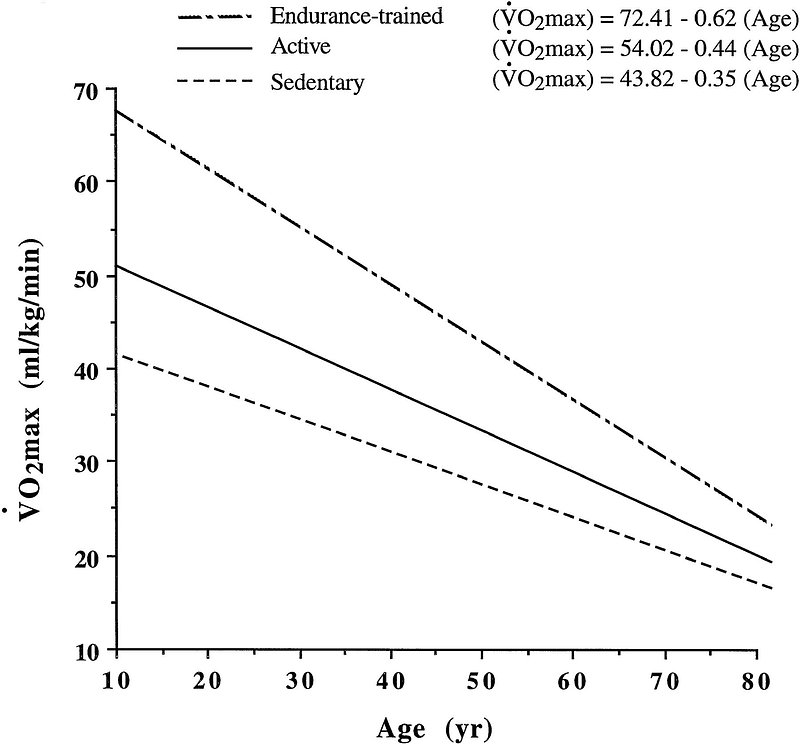
In a study of 810 people followed for 8 years Fleg et al (2005) (ref) clarified that the decline is not linear, with a larger rate of decline after 60 years.
it actually looks like this (pretty much the same as strength effects above)…

Now, if you take the difference between these two groups ie trained and untrained, then it looks like this plot (red) and this is an indication how much you gain in absolute terms, if you train start training at a specific age.

BUT WAIT, there is another plot, which I have never seen before, it is the plot of the relative gains (vs untrained) you get by training (=(trained-untrained)/trained), and this is even more dramatic!

What these last two graphs show is that you make the largest, fastest absolute gains at an early age, but you *never* fail to benefit from training. In fact, if you didn’t train before (or had a big gap) then you should definitely begin to train later in life as the benefits are really large *relative to the norms* at your age. Not sure? Ok try this……
Please consider these three brothers: Tony, Javier and Deter

Each had a different lifestyle and each had a test on the bicycle erg every 10 years.
Tony is now 58yrs, and untrained after a life behind a desk. His V02 max is 18. Even at 30 yrs his V02Max best was 28.
Javier is also 58yrs but he a regular triathlete age grouper. His V02 max is 44 and at its best was 66.
Deter is 68yrs and he was always active and even now, does an online gym and spin class. His V02 max is 27 but at his best was 49. Confused? OK, here is all their VO2max test results (from past and future) from every decade lined up:
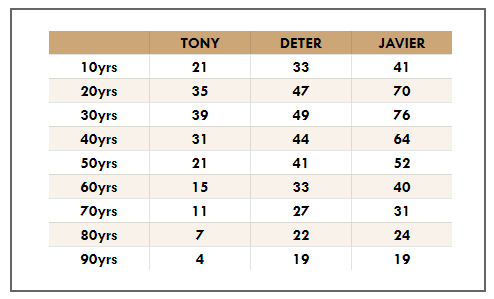
Tony’s VO2max is in danger of impacting on his independence, if not mortality from 70yrs. Indeed Posner et al (pdf) showed that the ability to perform activities of daily living was not dependent on aerobic fitness until peak V̇o2 dropped below ≈750 mL/min (or around 12 ml/min @60kg)
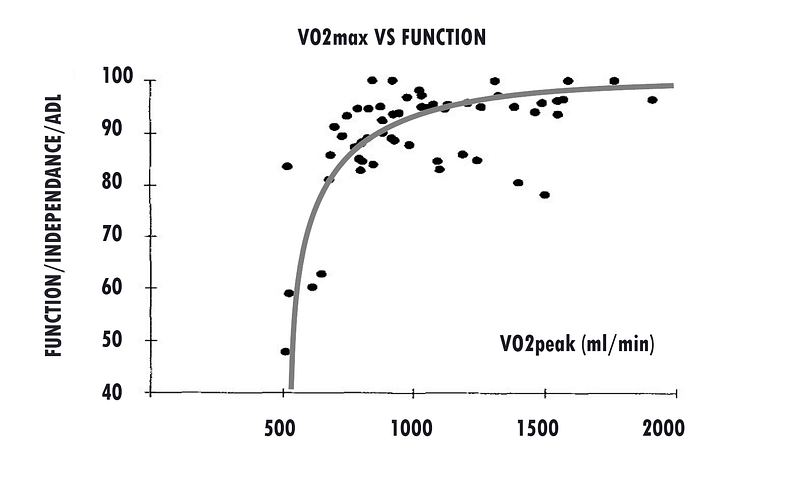
Javier’s VO2max is almost 2.5x Tony’s. Deter, despite being 10 years older has a healthy VO2max, still 1.7x Tony’s and he will stay healthy well into his 90s.
This massive relative benefit of training with age will maximize quality of life, so that healthy living lasts longer and morbidity / illness / dependency is much less as shown here:
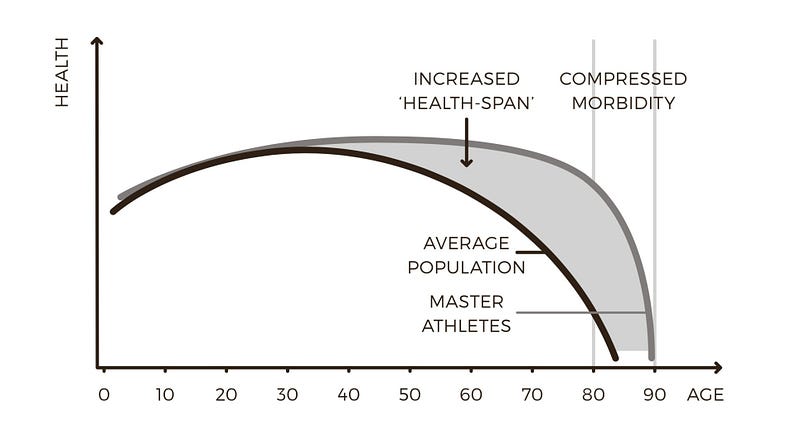
Conclusion
Some decline in performance is inevitable with age but the good news is you can vastly mitigate this by training consistently. In fact, the older you are, then the more relative benefit you will get from training. So if you have had a big gap in your training, or you are new to training in your 50s, 60s or 70s then now is the perfect time to restart.
In the next blog, we will consider the mechanisms by which we age. Its here.

